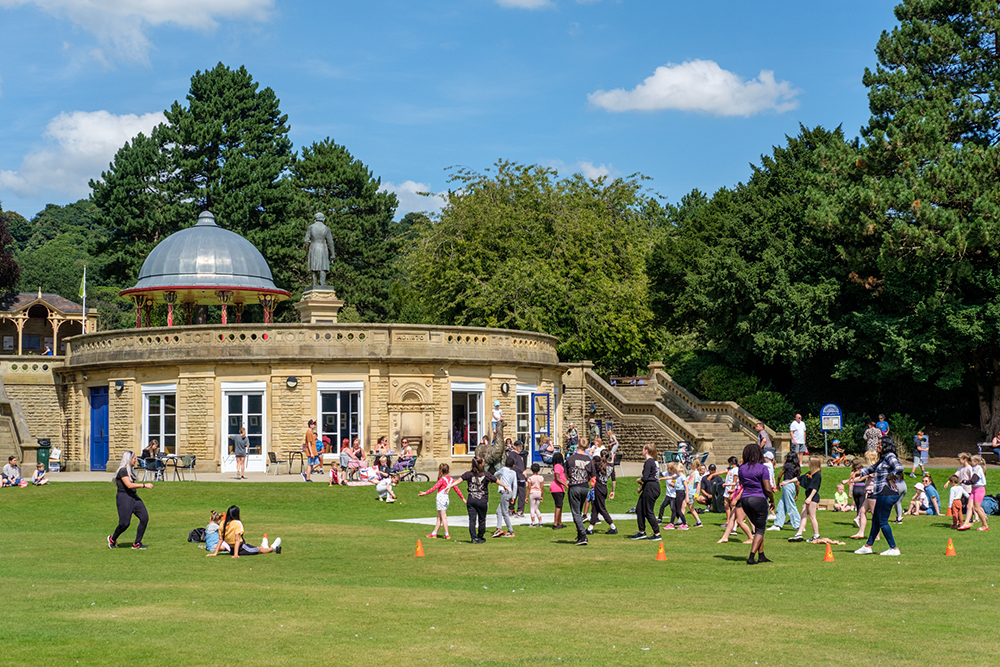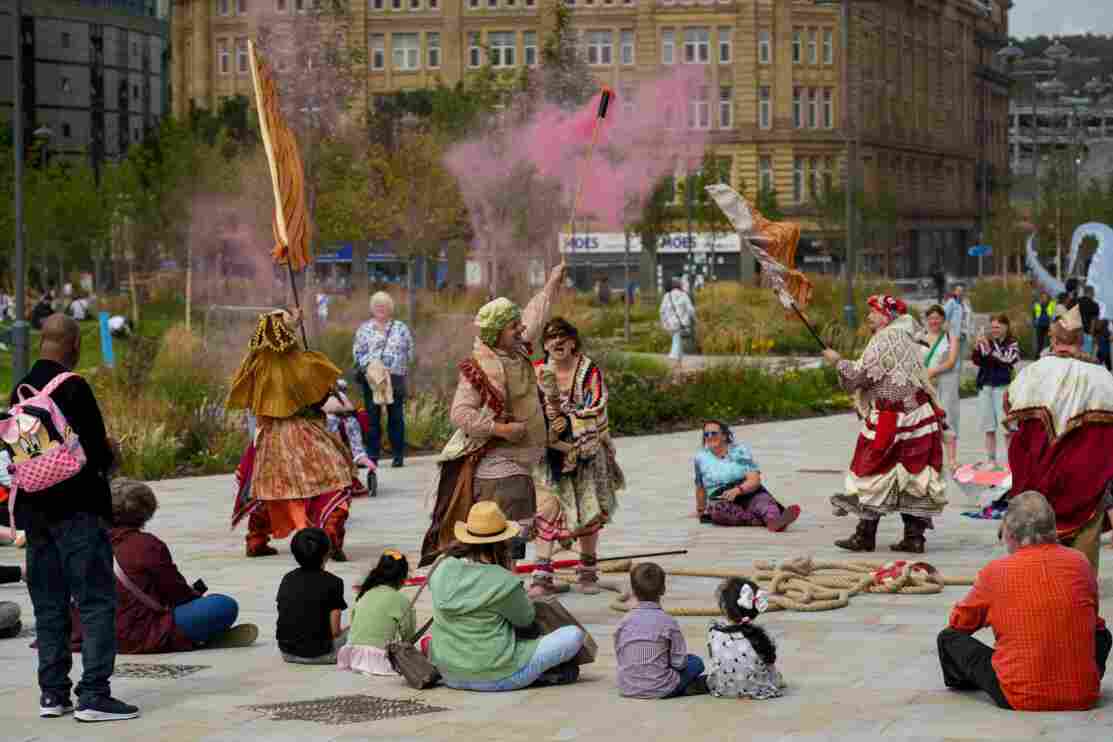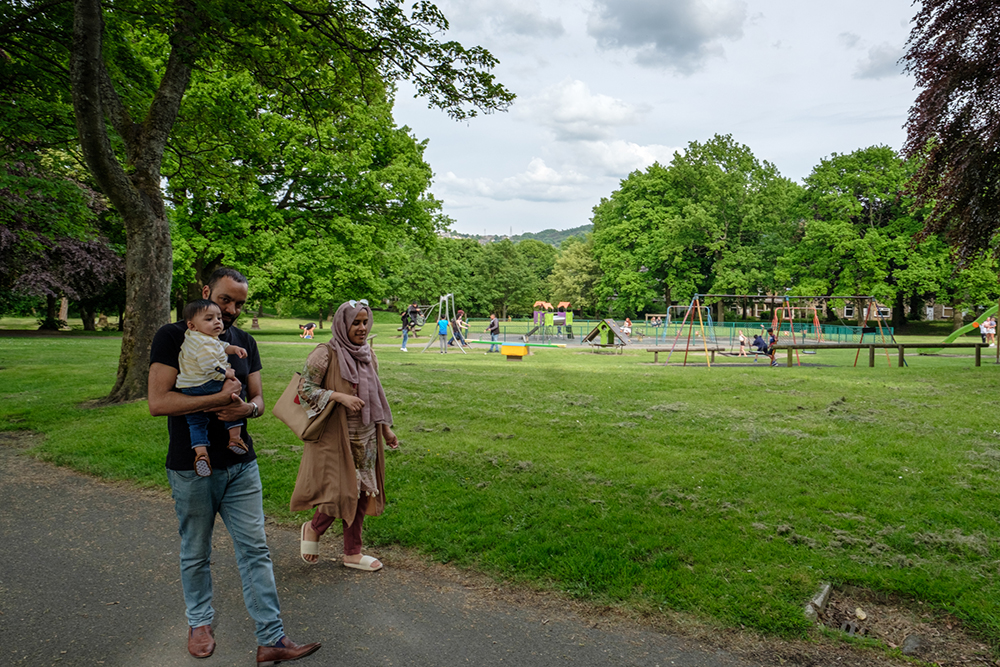Statement of Community Involvement 2025
2. Community and Engagement in Bradford District
This chapter is about Community and Engagement in Bradford District.
If you'd like to leave a comment you can do so by answering the question at the bottom of the page.
2.1 Our District Profile
2.1.1 Bradford is a large metropolitan authority which covers approximately 370 sq km (143 sq miles) and forms one of the five districts within the West Yorkshire conurbation. The district is located within the Leeds City Region.
2.1.2 The Bradford District is characterised by a mixture of urban and rural areas with distinctive character and attractive landscapes. The topography of Bradford means most of the residential and industrial development is in the south of the district and along the valley bottoms of the Rivers Aire and Wharfe and their tributaries, with much of the population living in the urban centre of Bradford and within the separate settlements of Keighley, Bingley and Shipley, in Airedale, and Ilkley, in Wharfedale. While the urban areas are quite densely developed, two-thirds of the district is rural with moorland and attractive valleys surrounding the urban areas.
2.1.3 Bradford is the fifth largest local authority in England in terms of population after Birmingham, Leeds, Sheffield and Manchester.
2.1.4 Bradford has a population of 560,200 (ONS, mid-2023 population estimate) of which 49% were male and 51% were female. 23% were aged 0-15, 62% were aged 16-64 (working age population) and 15% were aged 65 and older.
2.1.5 A large proportion of the district's population were aged under 20 (28%) and 70% are aged under 50. The age profile of the District is also getting older, with more people living over the age of 75 years.
2.1.6 The population is ethnically diverse. While the largest proportion of the district's population identifies themselves as White British (57%), the remaining 43% of the population is of ethnic minority origin (2021 Census). This is an increase from the 2011 Census, where 36% of the population was of ethnic minority origin. The district's community characteristics will form a major consideration in seeking to achieve effective and representative methods of engaging the community.
2.1.7 In terms of disability, 19% of residents identify as disabled according to the 2021 Census, slightly higher than the average for both Yorkshire and the Humber region and England.
2.1.8 An understanding of the local population characteristics of the District is an important foundation to effective consultation and participation. The SCI is tailored to ensure all communities are better informed and more involved in planning.

2.2 Benefits of Community Engagement
2.2.1 Local residents and stakeholders are active users of places, spaces and services, and possess invaluable knowledge and experience of their communities. The Council therefore believes that involving people fully and creatively in the design, development and delivery of its planning services is crucial.
2.2.2 This will not only ensure that the right services are more likely to be delivered but also ensure that they will be of better quality with greater community support for policies, strategies and decisions. Stakeholders and community groups can also empower local residents to ensure local needs are addressed and influence how development is delivered in the District.
2.3 General Engagement Principles
2.3.1 In support of better engagement, the SCI sets out a series of six general principles:
- Early engagement – aim to ensure communities are engaged at the earliest practical stage in the planning process.
- Clear communication – continue processes that ensure communities understand the scope of engagement, constraints imposed by policies and legal regulations, proposal details and decision-making processes. This includes the use of less technical language and illustrative material where appropriate.
- Inclusive and proactive – aim to establish a good range of views and voices from all of those who live and work in the district are obtained, including those previously underrepresented groups.
- Use appropriate consultation methods - use consultation tools and approaches that are appropriate to the stage of the planning process, the issues being considered, the communities involved and within the context of a prudent use of resources. There are a range of consultation tools available to the Council which are set out in the relevant section below.
- Effective feedback – provide feedback on consultation comments and set out how comments raised have been considered and addressed.
- Digital innovation – continue to use electronic methods of consultation including online engagement portals and the Council's website to make involvement easier, quicker and more cost effective. Within good practice, guidance and relevant policy constraints utilise Artificial Intelligence (AI) to support the efficient processing of consultation comments.
2.3.2 The consultation tools used as part of community involvement can vary according to the different types of planning processes and stages of development.
2.4 Consultation Tools
2.4.1 Figure 2 below set outs a series of consultation tools that can be tailored to meet particular needs. Not all tools need to be applied for all types of consultations and the list provides a toolkit or portfolio of options only.
Figure 2: Consultation Toolkit
|
Consultation Channels |
Consultation Tools |
|
Website, Online Portals and Channels |
Council website – electronic copies of documents will be made available on the Council's website. The Council will ensure that documents meet the necessary legal requirements (e.g. accessibility requirements) and clear signposting is used to request an accessible or alternative format. Online consultation portal – consultation and engagement platforms (hosted online) will be used to communicate information and enable public comments or formal representations to be submitted through consultations. This will be one of the primary forms of consultation. Online meeting software – pre-recorded and live events. Video or online presentations – the use of digital methods will be used, where appropriate. |
|
Digital Bulletins and Newsletters |
Council's Corporate Information System – the 'Stay Connected' system will be used to issue electronic bulletin notifications to stakeholders and consultees who have self -registered an email address into the system or requested to be added. Newsletters – digital newsletters will be distributed electronically to stakeholders. |
|
Social and other Media |
Social media – information will be published through the Council's official social media outlets. Media / press - print, social online, TV and radio will be utilised to publicise consultations. |
|
|
Email – email correspondence and notifications, including notifications to consultees on the planning consultation database. Letters – hard copy |
|
Physical Material |
Documents - hard copies – physical copies of relevant planning documents will be made available at set deposit locations - within the main libraries within the District (Bradford, Shipley, Bingley, Keighley and Ilkley) and in the Council's main customer services buildings (Bradford and Keighley) Posters / leaflets – can be used to publicise consultations and will be sited in prominent community locations throughout the District. |
|
In person events |
Public exhibitions - drop in events will be used (where appropriate) for members of the public and stakeholders to attend. They will be used to publicise information about planning documents and provide an opportunity to ask questions. Public exhibitions may or may not involve the attendance of a Council officer. Focus groups or workshops – targeted sessions on particular planning or policy issues. Meetings:
Events:
|
|
Facilitated and supported Engagement |
Planning Aid England (PAE) – engage the services of PAE for independent and impartial professional planning advice.] Outreach networks – engage through forums, partnerships and local advocate and champions within local communities. |

2.4.2 The Council may use Artificial Intelligence (AI) within appropriate guidelines, policies and procedures to summarise consultation statements and identify key issues for further development.
2.5 Accessible / Alternative Formats and Access to Information
2.5.1 The Council is keen to ensure all members of the community can effectively engage in planning consultations. This will include supporting the use of assistive technology (such as a screen reader) and provision of material in different languages and alternative formats such as Braille, tape, audio, disc or large print. It will be important to tell us what format you need and also what assistive technology you use.
2.5.2 The Council will make available hard copies of documents upon request during a consultation period. The Council however reserves the right to make a reasonable charge for the document to cover administration, materials, and printing costs. The cost of documents will vary depending on its size and any requirements to use colour printing; these will be made available during the consultation upon request.
2.5.3 Information relating to consultation on the local plan, neighbourhood plans and supplementary planning documents will be made available in a variety of ways. The Local Plan will be made available to view and download on the Council's web site at www.bradford.gov.uk/planningpolicy
2.5.4 Public access to the Internet is available at all libraries across the District and in the main Council customer offices. Paper copies of Local Plan documents will be made available for inspection upon request at the Council's principal offices during normal office hours and main libraries as detailed in Appendix 1. The Council reserves the right to update this Appendix subject to changes in resources and assets.
2.5.5 Copies of Neighbourhood Planning documents, which relate to a small or parished area, will be placed in the Council's main office along with the libraries within and adjoining the settlement or parish which is the subject of the consultation.
2.5.6 The Council, in producing documentation relating to the Local Plan, will seek to make publications as user friendly to the reader as possible by using Plain English and avoiding an overuse of planning jargon. It will also seek as far as practical to make them printer friendly and easy to review and access through digital technology including smart phones.
2.6 Legal Requirements
2.6.1 There are several requirements set out in planning legislation as to various stakeholder groups who may engage in planning processes and development management.
2.6.2 In relation to plan-making, under the Town and Country Planning (Local Planning) (England) Regulations 2012, as amended, the Council needs to ensure that information is made available to specific consultation bodies; general consultation bodies and other consultees. The definitions of these groups of stakeholders are set out below and further details provided in Appendix 2:
- Specific consultation bodies – groups with expertise of a particular subject as defined through the legal regulations;
- General consultation bodies – groups that represent the interests' of certain groups (i.e. age specific groups); recognised voluntary groups; and bodies that represent business in the District;
- Other consultation bodies – those who have an interest in planning; local representative bodies and local communities who have actively engaged in the preparation of the Local Plan and other planning documents.
2.6.3 In determining planning applications officers also need to consult a defined set of statutory consultees which are relevant to the applications as established through the various statutory orders and regulations. These are currently defined in Appendix 3.
2.6.4 The Council has a legal responsibility (under the Localism Act 2011 and the NPPF) to work constructively with neighbouring authorities and prescribed bodies under 'Duty to Cooperate' (DtC). This duty requires LPAs to consider planning issues which extend beyond its own administrative boundary. The Council will carry out its Duty to Cooperate responsibility and document process through an action plan approach and supporting material including the production of a statement of common ground. Appendix 4 includes a list of Duty to Cooperate organisations as defined by the statute and regulations.
2.6.5 The Council also has a duty to assist and support local communities in the borough in the preparation of Neighbourhood Development Plans. Further information can be found in The Neighbourhood Planning (General) Regulations 2012 and section 3 of the SCI. Neighbourhood Plans, introduced by the Localism Act 2011[2], are a way of ensuring people in our communities can influence the planning of the area in which they live and work. Information on made and developing neighbourhood development plans can be found on the Council's website.
2.6.6 For plan-making, the Council maintains a 'Consultation Database' (an amalgamated database of Stay Connected and Planning Policy contacts) which includes contact details from stakeholder groups and people who have made representations during formal plan-making stages, or expressed an interest in being kept informed about planning policy matters. This database is regularly updated and individuals and stakeholders can self-manage their personal records, opting to be added or removed from the database in line with the Local Plan Privacy Notice.
2.7 Under-Represented Groups
2.7.1 The Council is committed to engaging with under-represented groups and has a number of partnerships, networks and organisations which will facilitate this engagement.
2.7.2 The Council has identified the following are under-represented groups:
- Children, young people and older citizens
- People with disabilities or sensory loss
- Ethnic minorities[3]
- Homeless people
- Gay, lesbian, bisexual and transgender community (LBGT)
- Gypsy, Roma and Traveller ethnic groups
2.7.3 In addition, it is also important to engage with the 'inactive majority' – this refers to the majority of the population, that is people who have little spare time, or who are disillusioned or disinterested in being consulted.
2.7.4 Additional information and approaches to the engagement of less represented groups is set out in section 5 of the SCI.
2.8 Role of the Voluntary, Community and Social Enterprise (VCSE) Sector
2.8.1 In Bradford District and Craven, the VCSE includes more than 5,000 registered and unregistered groups which support people in many areas of their lives from youth groups, ageing well support, sports and wellbeing clubs to name a few. VCSE organisations bring a wide range of experiences and voices, as well as creative and agile ways of working. They are supported by an extensive and valuable network of volunteers.
2.8.2 The Voluntary and Community Sector (VCS) is represented by the Voluntary and Community Sector Alliance (VCSA) that works across Bradford District and Craven, and has been developed by the local Voluntary, Community, and Social Enterprise (VCSE) Sector to become an equal partner in the Integrated Care System.
2.8.3 The VCSA manages VCS representation on different Partnership Groups associated with Health and Social Care, and co-ordinates the local Voluntary and Community Sector to deliver different Health and Social Care projects across the Bradford District and Craven.
2.9 Stronger Communities Partnership
2.9.1 The Bradford Stronger Communities Partnership drives and oversees the delivery of the Bradford for Everyone Strategy 2018-23. Its purpose is to ensure that work designed and delivered under this strategy achieve the best outcomes for all people living in the Bradford District.
2.10 Ward, Town and Parish Councillors
2.10.1 Directly elected Ward councillors are an important interface between communities and the Council. It is important to involve local Ward Councillors from the beginning of the planning process. To facilitate their role in communities Councillors will be offered targeted briefing sessions, where appropriate, to disseminate information in advance or close to the start of the consultation.
2.10.2 Tailored engagement will also be undertaken with town and parish councillors who are close to local communities and key issues and concerns. This engagement may be through established forums or groups of towns and parish councillors.
2.11 Co-ordinating Consultations
2.11.1 The Planning Service will work collaboratively with other departments across the council. Joint-working is a more efficient use of resources (staff time and money). The Council operates a Consultation Calendar that is available on the Council's website, together with the nature and purpose of the consultation, prior to consultation. The consultation calendar is regularly updated.

Please use the buttons below to either support or object with comments or simply provide comments including any suggested changes to this chapter. You can also upload supporting information.
[2] The Locality Act also introduced Neighbourhood Development Orders (NDOs) and the Community Right to Build Orders – further information is available here: https://neighbourhoodplanning.org/
[3] Government uses 'ethnic minorities' to refer to all ethnic groups except the White British group. Ethnic minorities include White minorities, such as Gypsy, Roma and Irish Traveller groups. https://www.ethnicity-facts-figures.service.gov.uk/style-guide/writing-about-ethnicity/

